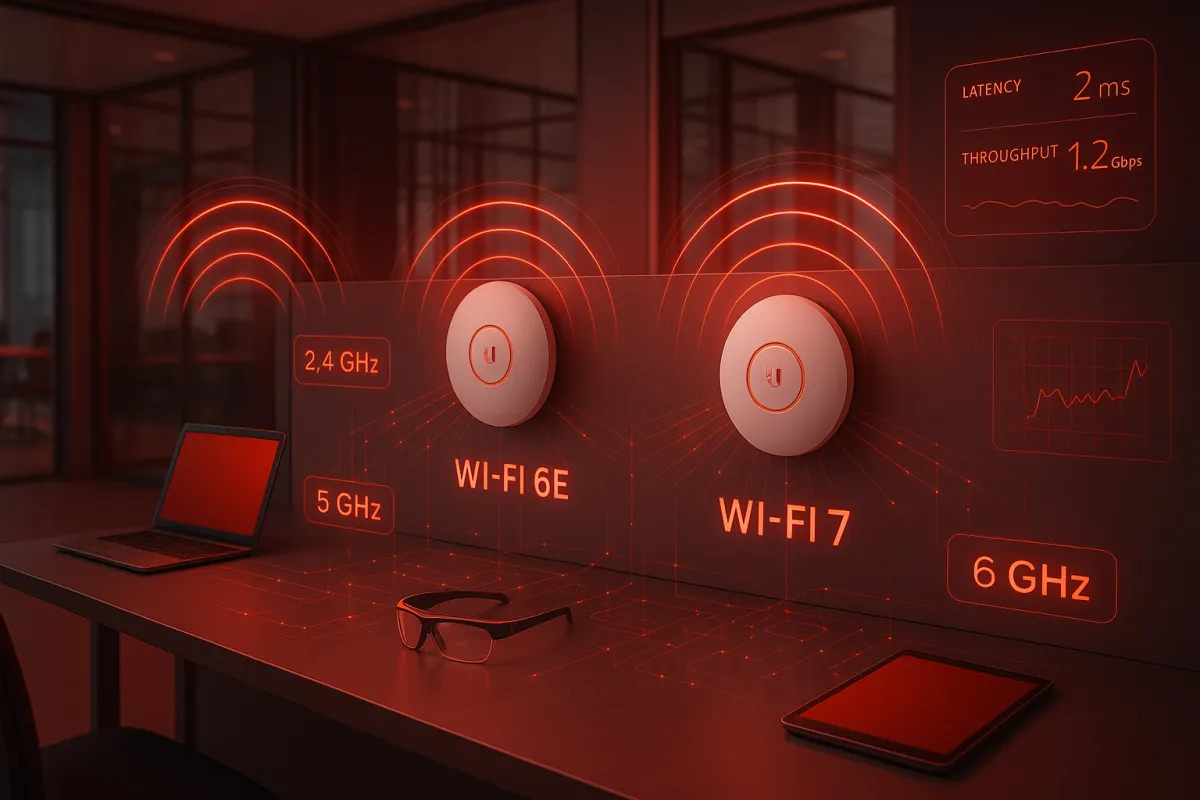
EnTech IT Solutions Blogs
Helpful Blogs Posts to keep you in the know!

Wi-Fi 6 vs Wi-Fi 6E vs Wi-Fi 7: The Ultimate Comparison for Business and IT Leaders
Wi-Fi 6 vs Wi-Fi 6E vs Wi-Fi 7: What Business Leaders and Technologists Must Know
Introduction: Navigating the Evolution of Wireless Standards
Why CEOs, CIOs, and Network Engineers Need This Guide
The evolution of Wi-Fi standards—from Wi-Fi 6 to 6E to 7—has direct impacts on speed, scalability, and business efficiency. This guide offers a clear breakdown for leaders and technicians to make informed decisions.
The Role of Ubiquiti and Enterprise-Grade Wi-Fi
Ubiquiti's UniFi and AmpliFi platforms are widely adopted in both SMB and enterprise markets. Their evolution offers real-world perspective on how each Wi-Fi standard performs in professional deployments.
What Is Wi-Fi 6?
Overview
Wi-Fi 6 (802.11ax) was introduced in 2019 with major improvements in multi-device efficiency and reduced latency.
Key Technologies
OFDMA (multi-device efficiency)
MU-MIMO (multi-user communication)
Target Wake Time (better battery life)
Best For: Offices, schools, multi-user networks, and BYOD environments.
What Is Wi-Fi 6E?
Extended Spectrum
Wi-Fi 6E extends Wi-Fi 6 into the 6 GHz spectrum, unlocking more lanes for traffic and minimizing interference.
Advantages
6 GHz spectrum access
Lower latency and congestion
Great for 4K/8K video, AR/VR, and enterprise IoT
Limitations: Requires 6E-compatible devices. Not all countries support 6 GHz.
What Is Wi-Fi 7?
Next-Gen Wireless Features
320 MHz channels (double the bandwidth)
Multi-Link Operation (simultaneous use of multiple bands)
4096-QAM (more data per signal)
⚠️ Note:
To take full advantage of Wi-Fi 7 features—like 320 MHz channels, Multi-Link Operation, and 4096-QAM—you need Wi-Fi 7-compatible devices (both router and endpoint). Without them, the network will default to the highest supported version.
Top 10 Wi-Fi 7-Compatible Devices (2025)
Samsung Galaxy S24 Ultra
OnePlus 12 Pro
Xiaomi 14 Ultra
Google Pixel 9 Pro
ASUS ROG Phone 8 Pro
Lenovo ThinkPad X1 Carbon Gen 12 (2025)
Dell XPS 16 (2025)
HP Spectre x360 (2025)
ASUS Zenbook Pro 14 (2025)
Intel NUC 13 Extreme with Wi-Fi 7 PCIe card
Ideal For: Smart offices, virtual collaboration, and high-performance environments.
Feature Comparison Table
Security, Infrastructure & Compatibility
Security: WPA3 supported across all three
Infrastructure: Wi-Fi 7 may require multi-gig PoE switches and CAT6A cabling
Device Compatibility: Wi-Fi 7 is backward-compatible
Use Case Recommendations
CEOs: Strategic infrastructure investments
Technicians: Wi-Fi 6E for solid performance now
IT Managers: Phased Wi-Fi 7 deployments in high-traffic areas
Market Trends & Regulatory Notes
Wi-Fi 6/6E dominate current enterprise upgrades
Wi-Fi 7 gaining traction with flagship phones and laptops
U.S. fully supports 6 GHz; EU and Asia have varied spectrum allocations
Final Recommendation
SMBs: Wi-Fi 6 is cost-effective and reliable
Creative / AR/VR Teams: Wi-Fi 6E offers performance and wider lanes
Future-Ready Organizations: Wi-Fi 7 unlocks next-gen experiences
Conclusion
Wi-Fi upgrades are about more than speed. They’re about readiness, compatibility, and strategic foresight. Ubiquiti offers hardware across all three tiers — no recurring licenses, just scalable performance.
FAQs
Q1: What’s the difference between Wi-Fi 6E and Wi-Fi 7?
Wi-Fi 7 adds 320 MHz channels, Multi-Link Operation (MLO), and 4096-QAM — all boosting performance.
Q2: Will Wi-Fi 6 devices work with Wi-Fi 7 routers?
Yes. Wi-Fi 7 is backward-compatible.
Q3: Do I need to upgrade all hardware for Wi-Fi 7?
Not immediately. Start with high-demand zones and scale.
Q4: Is Ubiquiti offering Wi-Fi 7 yet?
Expected rollout in 2024/2025. Watch for UniFi updates.
Q5: Which industries benefit most from Wi-Fi 7?
Healthcare, AR/VR, gaming, remote collaboration, and smart manufacturing.

Connect
Call Or Text:






